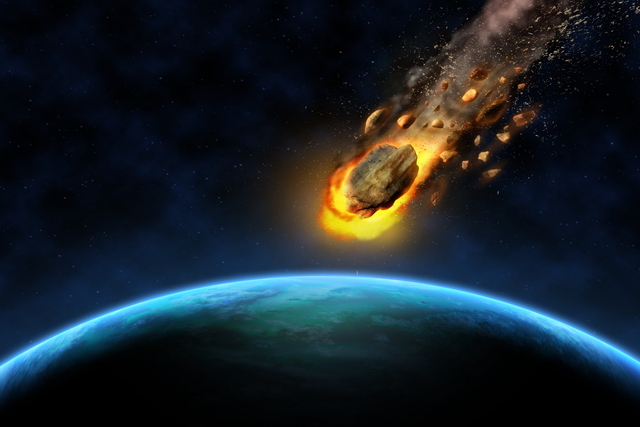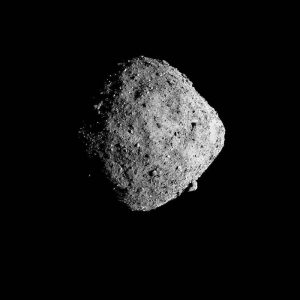Lurking within the cosmic dance of celestial bodies lies 99942 Apophis Asteroid, an asteroid that once stoked the flames of an apocalyptic narrative. Back in 2004, its trajectory sparked a wave of anxiety, propelling it to the dubious title of “Doomsday Asteroid” due to a calculated 2.7% chance of colliding with Earth in 2029. But fear not, Earthlings, for science has since offered a reprieve, demoting Apophis from its celestial throne of terror. Let’s embark on a journey to dissect this once-feared spacefarer, exploring its history, its near-miss with our planet, and the reasons behind its dramatic fall from grace.
From Shadowy Origins to Glaring Spotlight: The Discovery of Apophis

In the twilight hours of June 19, 2004, astronomers Roy Tucker, David Tholen, and Fabrizio Bernardi made a discovery that would send shockwaves through the scientific community. Nestled amidst the starry expanse, they encountered a rocky behemoth, later christened 99942 Apophis. Apophis, estimated to be roughly the size of the Empire State Building, quickly grabbed headlines, not for its celestial beauty, but for its unnervingly close brush with Earth in 2029.
A Brush with Oblivion: The 2029 Flyby and the Era of Anxiety
Initial calculations, shrouded in the uncertainties of orbital mechanics, painted a chilling picture. With a 2.7% chance of impact, Apophis became a celestial harbinger of doom. Newspapers splashed sensational headlines, and the public imagination conjured scenes of devastation. The potential consequences of a collision were staggering, ranging from regional tsunamis to widespread destruction and loss of life.
However, amidst the rising tides of anxiety, the scientific community embarked on a relentless pursuit of data. With each observation, Apophis’s orbital path came into sharper focus. By 2013, meticulous celestial sleuthing had effectively ruled out the possibility of an Earth impact in 2029. The collective sigh of relief, though audible across continents, couldn’t erase the valuable lessons learned during those years of uncertainty.
From Villain to Victim: Demystifying the Doomsday Hype
So, what transformed Apophis from a cosmic villain to a mere celestial wanderer? The answer lies in the power of scientific observation and meticulous data analysis. As astronomers diligently tracked Apophis’s trajectory, they identified a phenomenon known as the “Yarkovsky effect.” This subtle thermal force, arising from the uneven heating and cooling of the asteroid’s surface, ever so slightly altered its path, ultimately pushing it away from Earth’s collision zone.
Beyond the Hype: The Legacy of Apophis
While the immediate threat of impact has evaporated, Apophis’s legacy extends far beyond a headline-grabbing near-miss. It serves as a powerful reminder of the dynamic nature of our solar system, the constant interplay of celestial forces, and the crucial role of scientific vigilance in safeguarding our planet. Moreover, Apophis has catalyzed vital research and development in asteroid detection and deflection technologies, propelling us forward in our quest to become cosmic caretakers.
Celestial Shadows Looming Large: Comparing Apophis with Earth’s Other Potential Cosmic Cousins
While 99942 Apophis once captured headlines as a celestial harbinger of doom, its near-miss in 2029 has receded into the annals of astronomical history. But the vast expanse of space holds other potentially hazardous objects, reminding us that Earth remains a cosmic target in a celestial shooting gallery. So, how does Apophis stack up against these other celestial threats? Let’s embark on a comparative journey, unearthing the hidden dangers lurking within the solar system.
The Once and Almost King of Doom: 99942 Apophis
Apophis, estimated to be roughly the size of the Empire State Building, initially sent shivers down spines with its 2.7% chance of impacting Earth in 2029. However, meticulous celestial sleuthing, aided by the Yarkovsky effect, ultimately steered it clear of our fragile blue marble. Despite its dramatic fall from grace, Apophis serves as a valuable reminder of the ever-shifting celestial dance and the importance of vigilant asteroid tracking.

The Silent Stalker: Bennu, the Carbonaceous Conundrum
Unlike the flashy near-miss of Apophis, Bennu takes a stealthier approach. This roughly 500-meter-wide near-Earth asteroid harbors a composition rich in carbon, a vital ingredient for life as we know it. While its 2135 potential impact date is over a century away, Bennu’s carbonaceous bounty makes it a tempting target for future space exploration missions. However, this scientific allure comes with a caveat: even a glancing blow from Bennu could trigger regional devastation.
The Colossal Crusher: Didymos, a Binary Threat
Didymos isn’t content with just one celestial dance partner. This binary asteroid system consists of a larger primary body, Didymos A, and a smaller moonlet, Didymos B. While their individual sizes pose no immediate threat, the pair garnered attention as the target of NASA’s Double Asteroid Redirection Test (DART) mission. Launched in 2021, DART successfully impacted Didymos B in September 2022, marking a crucial step in testing planetary defense strategies against future asteroid threats.
Beyond the Big Three: A Universe of Celestial Concerns
While Apophis, Bennu, and Didymos capture much of the spotlight, the universe holds a vast menagerie of other potentially hazardous near-Earth objects (NEOs). Asteroids like Toutatis, with its close flybys of Earth every four years, and the potentially fragmenting object Phaethon, constantly remind us of the dynamic nature of our cosmic neighborhood.
A Cosmic Carousel of Celestial Concerns:
Comparing Apophis to other potential Earth threats reveals a diverse spectrum of risks. While Apophis’s initial near-miss drama has subsided, Bennu’s intriguing composition and Didymos’s role in testing deflection technologies highlight the multifaceted nature of asteroid threats. Ultimately, understanding the unique characteristics of each NEO is crucial in safeguarding our planet from the silent sentinels lurking in the cosmic shadows.
Remember, this is just a starting point. You can expand on each object’s specific characteristics, their potential impact scenarios, and ongoing research efforts to further enrich your comparative analysis. By weaving in engaging narratives, captivating visuals, and authoritative sources, you can create a truly compelling and informative piece that stands out in the competitive world of online content.
Doomsday Asteroid
Ah, yes! The “Doomsday Asteroid” of 2046, officially known as 2023 DW, was quite a story when it first emerged. While its initial detection sent shivers down spines due to a slim chance of impact on Valentine’s Day 2046, the good news is that the threat has since been significantly downgraded. Here’s a breakdown:
The Initial Hype and the Scary Numbers:
- Discovered in February 2023, 2023 DW was initially estimated to have a 1 in 625 chance of impacting Earth in 2046. This sent media outlets into overdrive, and the term “Doomsday Asteroid” became a catchy, if unsettling, moniker.
The Calming Down and the Numbers Game:
- As astronomers gathered more data and refined their calculations, the picture changed dramatically. By May 2023, the impact risk had plummeted to around 1 in 770, and it continues to decrease with further observations.
Where We Stand Now:
- As of January 2024, the chance of 2023 DW impacting Earth in 2046 is considered extremely low, hovering around 1 in 1,584. While technically not zero, it’s statistically less likely than winning the lottery twice in a row!
The Lessons Learned:
- The story of 2023 DW serves as a valuable reminder of the dynamic nature of celestial objects and the importance of continuous observation and data analysis. It also highlights the need for clear communication and responsible reporting during times of potential threats.
Looking Forward:
- 2023 DW will continue to be tracked by space agencies like NASA, and astronomers remain vigilant in monitoring the vast array of near-Earth objects. This commitment ensures we’re prepared to respond effectively to any future celestial challenges.
So, while the “Doomsday Asteroid” hype may have faded, the story serves as a captivating example of how our understanding of the universe constantly evolves. It’s a testament to the power of scientific inquiry and our ongoing quest to safeguard our planet from the wonders and potential dangers that lie beyond the Earth.
Remember:
- This information is based on current data and may change with future observations.
- It’s important to rely on reputable sources for accurate information about potential asteroid threats.
- While vigilance is important, there’s no need for immediate alarm regarding 2023 DW.

Frequently Asked Questions (FAQs) About 99942 Apophis Asteroid:
Q: Is Apophis still a threat to Earth?
A: No, as of January 2024, Apophis poses no known threat to Earth in the foreseeable future. Extensive observations have ruled out any possibility of impact until at least 2068.
Q: What would happen if Apophis did hit Earth?
A: The impact’s severity would depend on various factors, including the asteroid’s specific point of impact and angle of approach. However, even a glancing blow could trigger regional tsunamis, widespread infrastructure damage, and significant loss of life.
Q: Are we prepared to deflect an asteroid if necessary?
A: While current technology hasn’t been tested on a real-world scenario, significant research and development efforts are underway in asteroid deflection techniques. International collaboration and continued technological advancements are crucial in ensuring our preparedness for future celestial encounters.
Conclusion:
From harbinger of doom to celestial enigma, 99942 Apophis has been a captivating cosmic player. Its story not only underscores the precarious balance of our solar system but also showcases the triumph of scientific inquiry and global cooperation in the face of cosmic challenges. As we continue to gaze skyward, let the tale of Apophis serve as a beacon, reminding us of our delicate place in the universe and the vital role we play in safeguarding our future amongst the celestial orchestra.
